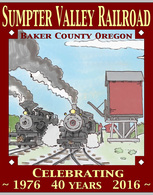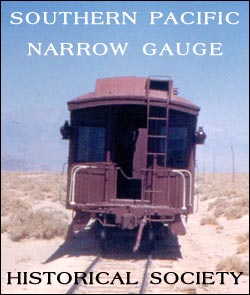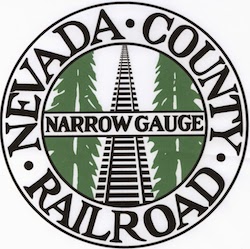

The Yeon & Pelton Company’s “Bastard Gauge” Railroad.
By Greg MaxwellLucky Jack Peterson and the Star Logging and Lumber Company
In May 1897 pioneer northwest logger J.H. “Lucky Jack” Peterson (also spelled Petterson), with banker W.B. Ayer and Portland attorney S.B. Linthicum formed the Star Logging and Lumber Company. The stated purpose of the company was to log several heavily timbered sections in the rugged hills south and west of Rainier, Oregon. Peterson’s timberlands were located in what was known as the Rinearson Tract, a vast expanse of old growth forest in the Beaver Creek watershed.
To move his timber to the Columbia River and the saw mills at Portland, Peterson built a log chute from top of the bluff to Rinearson Slough, 600 feet below. In June 1897 work was began on a four mile railroad from the head of the chute to his timber along Beaver Creek. For motive power, three steam dummies were purchased. The locomotives were acquired from a Portland street railway, the Willamette Bridge Company, which was in the process of electrification. The 42 inch gauge of these engines is what determined the odd gauge of Peterson’s railroad. In 1898 the company acquired the Smith Brothers sawmill at Rainier. It was reported in 1899 that Star Logging and lumber had five steam donkeys in use and that they were sending 100,000 board feet of logs down their chute every day
Yeon & Pelton CompanyIn December 1901 Jean Baptist “John” Yeon, David C. Pelton and James H. Booth purchased the Beaver Valley timber lands and the railroad from Peterson for $100,000. The sawmill at Rainier was not included in the sale. On December 29, Yeon and his partners incorporated as the Yeon & Pelton Company to carry on the logging operation.
Yeon had concluded that almost 15% of the logs that Peterson had sent down his chute were damaged beyond use for the manufacture of lumber. To eliminate this terrible waste, Yeon devised a half mile railroad incline to run parallel to Peterson’s log chute. When the incline was completed in 1902, it was the first logging incline in the Columbia Basin and was considered a marvel. Lumbermen traveled from across the US and Canada to see it in action. Most of the 2,400 foot distance traveled by the incline fell at a steady 33%. At the top of the incline was a mammoth (for the time) 16x20 hoisting/lowering engine built by the Willamette Iron and Steel Company of Portland. Three sets of loaded disconnect trucks were sent down the incline at a time. The total elapsed time for the three loads to make the round trip was 20 minutes. On average, 60 loads of logs were dumped into Rinearson Slough daily, amounting to 400,000 board feet. The total output was rafted to the North Pacific Lumber Company’s big mill in Portland.
As logging progressed, the narrow gauge railroad was extended an additional six miles up the Beaver Creek Valley. In 1903 the Yeon & Pelton Company purchased the railroad’s first new locomotive, a 45 ton Climax. By 1905 the logging operation rostered four locomotives, 25 sets of disconnect tucks and six Willamette steam donkeys. It was said to be the second largest logging outfit on the west coast, employing 150 men. As the 1905 logging season came to a close, John Yeon decided to retire and sell the company. He had come to Oregon in 1885 at age 20 with nothing more than $20 and the clothes on his back. When Yeon left the Oregon woods at the end of 1905 he had sold his logging operation for $225,000. He would turn this small fortune into millions, speculating in Portland real-estate. When he passed away in 1928 he was one of Portland’s wealthiest men.
Portland Lumber CompanyOn January 1, 1906 the Portland Lumber Company took possession of Yeon & Pelton’s camps, railroad and approximately 125,900,000 board-feet of standing timber. This was added to the company’s other logging operations at Grays River and Cathlamet, Washington, to provide timber for their large sawmill in Portland. Through the winter of 1906 a large crew was kept busy extending the railroad up the Beaver Valley. That spring the company began harvesting the vast timber lands accumulated by John Yeon.
The Portland Lumber Company would add two more locomotives to their stable of 42” gauge iron ponies. A new Shay was delivered in 1907, and a second Shay was transferred from their Cathlamet operation in 1910 and converted to narrow gauge. To streamline the transportation of logs, construction was started on a direct rail route to Rinearson Slough in June 1910. The new line would eliminate the slow process of lowering log cars down the Yeon & Pelton incline. It would take three months to carve out the switch back grade down the bluff. Trains began delivering logs straight to the dump in September. For the next three years the Portland Lumber Company’s bastard gauge line would continue to be one of Oregon’s “high-ball” logging outfits. However, midway through the 1914 logging season it was announced that due to soft lumber prices the Beaver Valley camps would close.
Noyes-Holland Logging CompanyThe operation remained idle all through 1915. In December 1915 Howard H. Holland, Robert H. Noyes, and their attorney, Robert T. Platt organized the Noyes-Holland Logging Company to purchase the railroad, camps, the booming grounds on Rinearson Slough and 1,947 acres of timber for $450,000. For the next four years, the company employed about 125 men cutting timber along Beaver Creek.
By 1919 their timber in the Beaver Creek Valley was exhausted. Noyes-Holland seeking new opportunities entered into a contract with the Blodgett Co. Ltd of Grand Rapids, MI to log a block of timber in western Columbia County. The timber was located near the standard gauge Columbia and Nehalem River R.R. (the so-called Kerry Line). At the end of the 1919 logging season the two Shays were regauged to 4’ 8 ½“ and sent to a new logging railroad then under construction; branching off of the Kerry Line at Horseshoe Camp. The bastard gauge railroad was taken up and the remaining steam dummy, #4 was junked.
Donald Alanen, The Logger’s Encyclopedia, Baltimore, MD: Publish America, 2008
Kramer Adams, Logging Railroads of the West, Seattle, WA: Suprior Publishing, 1961
Richard Dunn, Steve Hauff, Dennis Thompson, The Climax Locomotive, Arlington, WA: Oso Publishing, 2002 Vernon Goe, John Labbe, Railroads in the Woods, Berkley, CA: Howell-North, 1961
Merve Johnson, In Search of Steam Donkeys, Hillsboro, OR: Timber Times, 1996
John Labbe, Fares Please! Those Portland Trolley Years, Caldwell, ID: Caxton Printers LTD, 1980
Columbia Register (St Helens, OR): 6-17-1904, 12-15-1905, 12-29-1905
Morning Astorian: 9-7-1899
Morning Oregonian (Portland, OR): 12-25-1901, 12-27-1901, 12-8-1905
Oregon Mist (St Helens, OR): 4-15-1898, 9-8-1899, 4-4-1902
Sunday Oregonian: 12-29-1901, 5-21-1905, 7-9-1905
Reference Material Available Online:
Photographs.
Collected Yeon and Pelton Company Photographs.
Images collected from private collections, libraries and historical societies.



